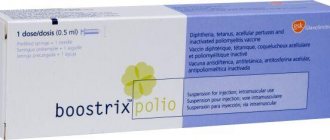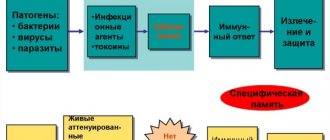To vaccinate or not?
The issue of childhood vaccinations causes perhaps the most heated debate among modern parents. “Vaccinators” appeal to the fact that vaccination is the only proven way to train the immune system to fight deadly infections, and it is obviously safer than a previous illness. “Anti-vaxxers” point out the unwanted side effects that are possible with vaccination. In fact, blindly following everything that is prescribed at the district clinic and categorically denying all the achievements of modern medicine are equally meaningless. Most parents would still like to make a balanced, informed decision. This means that each specific vaccine should be considered separately.
In this case, we are talking about vaccinating a child under one year old against whooping cough, diphtheria and tetanus. Is vaccination aimed at preventing these diseases justified?
Description of the drug
The Infanrix vaccine is the latest combined vaccine based on safe pertussis antigens, the first vaccine in Russia for the prevention of whooping cough, diphtheria and tetanus with an acellular pertussis component.
Infanrix is used to prevent diseases characterized by severe course and possible death. The relevance and prevalence of these infections continues to this day, and the low incidence rate is ensured solely by creating an “immune layer” through vaccination from an early age.
Why vaccinate your child against tetanus?
Tetanus is extremely dangerous: the mortality rate from this disease reaches 80% of the number of cases, among newborns - 95%. The course of tetanus is very painful: there are known cases of such severe convulsions that the patient’s bones were broken. Even if the patient survives, immunity to tetanus does not develop after the illness, and it can be infected again, but the damage to the central nervous system is irreversible.
The causative agent of tetanus is found in the intestines of humans and animals, from where it enters the ground along with the feces or bodies of dead animals. Hence the widespread belief that it is impossible to become infected with tetanus if you do not play in places of mass burial of people or animals. This condition is unlikely to be met: the tetanus causative agent can persist in the soil for more than a hundred years, and the burial of domestic animals in Russia is often spontaneous.
Why vaccinate your child against diphtheria?
Diphtheria (true croup, also known as “choking disease”) is transmitted by airborne droplets and is highly contagious. This is one of the diseases for which herd immunity is very important. Thus, since 1974, the disease was considered completely defeated thanks to mass vaccination, but in 1997, due to refusals to vaccinate, an outbreak of this disease was again recorded. Children are especially susceptible to diphtheria; about 25% of cases are very severe. As complications, diphtheria can cause paralysis, polyneuritis and myocarditis - inflammation of the heart muscle.
At the same time, diphtheria toxoid is one of the safest vaccines. Severe reactions to it are quite rare.
Why vaccinate your child against whooping cough?
Whooping cough is especially dangerous for children under two years of age because it can cause respiratory failure. At the same time, whooping cough is one of those diseases for which antibodies against which are not transmitted through mother's milk, even if the mother was vaccinated or had whooping cough. Even having whooping cough does not provide lifelong immunity after recovery.
The mortality rate from whooping cough among those ill in the first year of life is 50-60%. In addition, whooping cough can cause complications such as pneumonia, cerebral hemorrhage, and rupture of the eardrum.
How does Infanrix differ from DTP?
“Anti-vaxxers” have perhaps the most complaints about the DTP vaccine among the entire range of vaccines that are administered to children in the first years of life. The reason for this is that DTP is quite difficult for children to tolerate. Many vaccinated people report high fever and poor health for several days after vaccination. Strong side effects are associated with the pertussis component of DTP - this is why neurologists and pediatricians recommend ADS-M instead of DTP for weakened children, that is, only diphtheria-tetanus toxoid, without whooping cough. Infanrix, unlike its domestic analogue, does not contain cells of the whooping cough pathogen.
To form an immune response, only three antigens (out of approximately three thousand) are extracted from these cells, which are used in the vaccine. This does not affect the effectiveness of Infanrix, but it is much less allergenic, much less often accompanied by fever and is easier to tolerate.
It also follows from this difference that during repeated vaccination or revaccination it is possible to switch to Infanrix after DTP, but vice versa is undesirable. If the first vaccinations contained only three antigens, you should not switch your child to a vaccine containing whole cells of the whooping cough pathogen.
DTP or Infanrix vaccination: which is better?
Pediatricians, including Komarovsky, recommend using DTP for the first vaccination, and if there are no complications after its administration, use it for the second, third vaccination, as well as revaccination, since the domestic vaccine gives a higher immune response.
If after the first administration the child experiences a severe reaction, it makes sense to switch to Infanrix. One of the advantages of using an imported vaccine is that it is sold already filled into a syringe - this eliminates the possibility of infection due to the use of an unsterile instrument.
An absolute contraindication to the use of a vaccine - domestic or imported - is the manifestation of an anaphylactic reaction in a child - i.e. a very severe allergy to one of its components, immunodeficiency, or any acute illness.
The domestic DTP is approved by WHO and recommended for use in accordance with the vaccination calendar.
Infanrix or Pentaxim?
Infanrix is not the only foreign-made vaccine that uses antigens isolated from the pertussis pathogen instead of whole cells. Pentaxim, also a very well-known foreign analogue of DPT, is produced using the same scheme. Which one should you choose?
They are very similar in composition and action, so it is logical to use the vaccine that is more accessible to you at the moment. However, there is one significant difference to consider. Infanrix contains only tetanus, whooping cough and diphtheria toxoids. Pentaxim, in addition, contains components for the prevention of hemophilus influenzae infection, as well as polio, that is, it is a five-component vaccine. This means that if you have already chosen Infanrix or Pentaxim, at the next vaccination or revaccination you will not be able to replace one with the other, since the vaccination protocol against polio and Haemophilus influenzae infection will not be completed to the end.
Should I combine all five components or get by with three, preferring Infanrix? The choice is up to the parents. Some believe that multicomponent vaccines create too high a one-time antigenic load on the body. Others rely on the National Vaccination Calendar, which provides for simultaneous vaccination against several diseases (without indicating how many vaccines are used). The Infanrix line has additional vaccines - Infanrix IPV (whooping cough, diphtheria, tetanus, polio) and even Infanrix Hexa (the same four diseases plus hepatitis B and hemophilus influenzae). The domestic DTP also has expanded options: Tetrakok (DTP + polio) and Bubo Kok (DTP + hepatitis B).
Diphtheria-tetanus vaccine "Infanrix"
Diphtheria-tetanus vaccine "Infanrix" three-component acellular pertussis adsorbed liquid
GlaxoSmithKline, England
Release form: 1 syringe containing 1 dose of vaccine against diphtheria, tetanus and whooping cough.
Vaccination schedule: according to the National Vaccination Calendar at 3, 4.5 and 6 months. life. Revaccination after 18 months.
INSTRUCTIONS FOR USE of the diphtheria-tetanus vaccine "Infanrix"
Infanrix is the first vaccine in Russia for the prevention of whooping cough, diphtheria and tetanus with an acellular pertussis component. Combined vaccine based on safe pertussis antigens. * acellular (cell-free) DTP vaccine; * 10 years of use worldwide; * effective and long-lasting protection proven during mass immunization; * immunogenicity corresponds to the reference DTP vaccine; * undeniable lower reactogenicity compared to whole-cell DTP vaccines; * fully complies with the National Vaccination Calendar of Russia. Latin name: INFANRIX / INFANRIX. Composition and release form: Infanrix suspension for intramuscular administration, 0.5 ml (1 dose); in syringes of 1 ml, 1 or 10 pcs. in packaging (complete with needles); in 3 ml bottles, 1, 10, 50 or 100 bottles per package (complete with or without syringes). 0.5 ml (1 dose) of the Infanrix vaccine contains: diphtheria toxoid not less than 30 IU, tetanus toxoid not less than 40 IU, detoxified pertussis toxin 25 mcg, filamentous hemagglutinin 25 mcg, pertactin (outer membrane protein with a molecular weight of 69 kDa) 8 mcg. The Infanrix vaccine is prepared in an isotonic sodium chloride solution and contains 2-phenoxyethanol as a preservative. Pharmacological properties: Infanrix is a trivalent purified pertussis-diphtheria-tetanus vaccine based on acellular pertussis components (a mixture of three purified antigens of pertussis pathogens), sorbed on aluminum hydroxide. Administration of Infanrix according to the approved vaccination schedule causes the formation of specific immunity against diphtheria, tetanus and whooping cough. The Infanrix vaccine meets WHO requirements for the production of substances of biological origin and vaccines against diphtheria, tetanus and pertussis. The protective effectiveness of the Infanrix vaccine reaches more than 88%. Immune response to primary immunization with the Infanrix vaccine: 1 month after a three-dose course of primary vaccination with Infanrix, carried out in the first 6 months of life, in more than 99% of immunized children, antibody titers to diphtheria and tetanus toxoids are more than 0.1 IU/ml. A secondary immune response to Infanrix pertussis antigens occurs in more than 96% of children. Immune response to revaccination with the Infanrix vaccine: After revaccination with the Infanrix vaccine in the second year of life (13-24 months), in all children who were primarily immunized with the Infanrix vaccine, antibody titers to diphtheria and tetanus toxoids are more than 0.1 IU/ml. A secondary immune response to Infanrix pertussis antigens occurs in more than 96% of children. The Infanrix vaccine practically does not cause anxiety, fever or post-infectious infiltration in the child. Indications: The Infanrix vaccine is intended for the prevention of diphtheria, tetanus and whooping cough in children: - primary vaccination against diphtheria, tetanus and whooping cough in children from 3 months; - revaccination of children who were previously immunized with three doses of pertussis-diphtheria-tetanus vaccine (DPT). Method of administration and dosage: The Infanrix vaccine is indicated for primary immunization of children, starting from the 6th week of life. Infanrix is administered deeply intramuscularly, alternating injection sites during the course of vaccination. SC and IV administration of Infanrix is contraindicated. The recommended single dose of Infanrix is 0.5 ml. The vaccination course consists of 4 vaccinations. According to the National Calendar of Preventive Vaccinations of Russia, primary immunization with Infanrix begins at 3 months of a child’s life according to the scheme: 3 - 4.5 - 6 months. The Infanrix vaccine is indicated for revaccination of children at 18 months of age if they have previously received three doses of acellular or whole-cell DTP vaccine. Before vaccination, the vial or syringe must be thoroughly shaken until a homogeneous suspension is obtained, making sure there are no foreign impurities or changes in appearance (if any, the Infanrix vaccine is not suitable for use). A vaccine with damaged integrity, lack of labeling, expired or improperly stored is not suitable for use. When using Infanrix in vials, the vaccination procedure is carried out in strict compliance with the rules of asepsis and antisepsis. Infanrix cannot be stored in an open bottle. The administration of Infanrix is recorded in established accounting forms. Contraindications: - severe complications that arose after the administration of the previous dose of the Infanrix vaccine (anaphylactic shock); - allergy to any component of the Infanrix vaccine; - progressive diseases of the nervous system, hydrocephalus and hydrocephalic syndrome in the stage of decompensation, epilepsy, epileptic syndrome with convulsive seizures; - anemia with a hemoglobin level below 80 g/l (preventive vaccinations can be carried out after an increase in hemoglobin levels). Side effects: Infanrix vaccine (with acellular pertussis component) is significantly less reactogenic compared to vaccines containing whole cell pertussis component. Some people vaccinated in the first two days after vaccination with Infanrix may develop short-term general (fever, malaise) and local (pain at the site of vaccine administration, hyperemia, swelling) reactions. Possible complications: convulsions associated with hyperthermia, allergic reactions (Quincke's edema, urticaria, polymorphic rash), exacerbation of chronic diseases. Considering the possibility of developing immediate allergic reactions in sensitive children, it is necessary to provide medical supervision for 30 minutes after vaccination with Infanrix. Special instructions and precautions: Infanrix vaccine should be administered with caution to persons with thrombocytopenia or hematopoietic dysfunction, since such patients are at risk of bleeding after intramuscular injection. To prevent bleeding, apply pressure to the injection site without rubbing for 2 minutes. Vaccination with Infanrix can be carried out on the same day as the administration of other vaccines according to the vaccination calendar. Infanrix should not be mixed in the same syringe with other vaccines. During storage of Infanrix, the suspension may separate into a white precipitate and a clear supernatant. Frozen Infanrix vaccine cannot be used. Storage conditions: In a dry, dark place at a temperature of 2–8 °C (do not freeze). Shelf life: 3 years.
← Back
How is Infanrix administered?
According to the National Vaccination Calendar, the first preventive immunization against tetanus, diphtheria and whooping cough is carried out at three months. As a rule, it is preceded by an examination of the child by a neurologist, who “gives the go-ahead” for vaccination or, on the contrary, a waiver from it according to indications, and then by a pediatrician.
Infanrix allows for shifts in the timing of vaccination in this case. This will not affect its effectiveness.
The second stage of immunization occurs at 4.5 months.
The third is for six months.
This first course of three procedures builds immunity a month after vaccination. Its effectiveness is 99% for diphtheria and tetanus, 95% for whooping cough.
Revaccination against whooping cough, diphtheria and tetanus is carried out at 18 months (one and a half years). During revaccination, a secondary response of the immune system is formed, which consolidates the effect of primary vaccination. Revaccination against diphtheria and tetanus is also given to children aged 7 and 14 years. In an adult, immunity against diphtheria and tetanus acquired as a result of vaccination lasts about 10 years.
Dosage regimen
A single dose of the vaccine is 0.5 ml.
The course of primary vaccination consists of 3 doses of vaccine administered according to the National Calendar of Preventive Vaccinations of Russia at 3, 4.5 and 6 months of life; revaccination is carried out at 18 months.
Before administration, the vaccine is shaken well until a homogeneous cloudy suspension is formed and examined carefully. If foreign particles, unbreakable flakes or changes in appearance are detected, the vaccine is not used.
Infanrix vaccine is administered intramuscularly and alternate injection sites during the course of vaccination.
Infanrix vaccine should not be administered intravenously under any circumstances.
Possible side effects of Infanrix
The instructions for the drug mention the following side effects of the vaccine as the most common: drowsiness, loss of appetite, irritability, anxiety, fever, itching and swelling at the injection site, vomiting, diarrhea. Infrequently, vaccination may be followed by headache, cough, rash, or lump at the injection site.
Adverse reactions occurring in more than 1% of vaccinated people are considered frequent. Any vaccination can cause an allergic reaction. Therefore, after the vaccination is administered, it is not recommended to leave the clinic for 30-40 minutes: in any office where vaccinations are given, there is a first aid kit for a quick response to possible anaphylactic shock. After this time has passed, an acute allergic reaction to the drug will no longer occur, and you can safely go home.
If a child's temperature rises after vaccination, it is recommended to ventilate the room in which he is located and maintain a humidity level above 70%. At temperatures above 38.5 °C, it is better to give an antipyretic, and if it rises above 40 °C, you should immediately call an ambulance. Be sure to give your child more fluids.
If any of the adverse reactions persist for more than two days, you should consult a doctor. This can happen when vaccinated with a low-quality vaccine (improperly stored or expired) or if the vaccination itself was done incorrectly, with a violation of sterility.
Vaccine Infanrix Hexa 0.5 ml/dose N1 suspension for injection
Release form
Suspension for intramuscular administration
Package
Syringe 0.5 ml.
pharmachologic effect
Infanrix meets WHO requirements for the production of biological substances and vaccines against diphtheria, tetanus and pertussis.
1 month after a three-dose course of primary vaccination with Infanrix, carried out in the first months of life, in more than 99% of children immunized with the Infanrix vaccine, antibody titers to diphtheria and tetanus toxoids are more than 0.1 IU/ml.
Antibodies to pertussis antigens (CA, PHA and pertactin) are produced in more than 95% of vaccinated people.
After revaccination with the Infanrix vaccine in the second year of life (13 - 24 months), in all children who were primarily immunized with the Infanrix vaccine, antibody titers to diphtheria and tetanus toxoids are more than 0.1 IU/ml.
A secondary immune response to pertussis antigens occurs in more than 96% of children.
The protective effectiveness of the Infanrix vaccine reaches an average of 88%.
Indications
— Primary vaccination against diphtheria, tetanus and whooping cough in children from 3 months.
— Revaccination of children who were previously immunized with three doses of acellular pertussis-diphtheria-tetanus or whole-cell pertussis-diphtheria-tetanus vaccine.
— When starting a course of vaccination with whole-cell pertussis-diphtheria-tetanus vaccine, it is possible to administer subsequent doses of acellular pertussis-diphtheria-tetanus vaccine and vice versa.
Contraindications
- Known hypersensitivity to any component of this vaccine, or if the patient has experienced symptoms of hypersensitivity after a previous administration of Infanrix.
- Severe reaction (temperature above 40°C, hyperemia or swelling more than 8 cm in diameter) or complication (collapse or shock-like state that developed within 48 hours after vaccine administration; continuous crying lasting 3 hours or more that occurred within 48 hours after administration of the vaccine; convulsions, accompanied or not accompanied by a febrile state, occurring within 3 days after vaccination) following the previous administration of the Infanrix vaccine.
— Encephalopathy that developed within 7 days after the previous administration of a vaccine containing a pertussis component. In this case, the vaccination course should be continued with diphtheria-tetanus vaccine.
special instructions
Carefully
The vaccine should be administered to persons with thrombocytopenia or hematopoietic dysfunction, as such patients are at risk of bleeding after IM injection. To prevent bleeding, apply pressure to the injection site without rubbing for 2 minutes.
Compound
One dose (0.5 ml) contains:
diphtheria toxoid - at least 30 IU
tetanus toxoid - at least 40 IU
pertussis toxoid (PA) - 25 mcg
filamentous hemagglutinin (FHA) - 25 mcg
outer membrane protein (pertactin) with a molecular weight of 69 kDa - 8 μg
Directions for use and doses
A single dose of the vaccine is 0.5 ml.
The primary vaccination course consists of 3 doses of vaccine administered according to the National Calendar of Preventive Vaccinations of Russia at 3, 4.5 and 6 months. life; revaccination is carried out at 18 months.
Before administration, the vaccine is shaken well until a homogeneous cloudy suspension is formed and examined carefully. If foreign particles, unbreakable flakes or changes in appearance are detected, the vaccine is not used.
The Infanrix vaccine must be administered intramuscularly and alternate injection sites during the course of vaccination.
Under no circumstances should the vaccine be administered intravenously!
Side effects
Clinical researches
The following set of safety parameters is based on data obtained from immunization of more than 16,000 patients.
As with DTaP vaccine and combination vaccines that contain DTaP, an increase in the incidence of local reactogenicity and fever following booster vaccination with Infanrix Hexa was reported compared with the primary course.
The following frequency of side effects per dose has been determined: very often (>10%); often (>1% and 0.1% and 0.01% and Infections and infestations
Uncommon: upper respiratory tract infections.
Metabolic and nutritional disorders
Very often - loss of appetite.
Mental disorders
Very often - irritability, abnormal crying, restlessness; often - nervousness.
From the nervous system
Uncommon: drowsiness; very rarely - convulsions (with or without fever).
Impaired breathing, thoracic and mediastinal function
Rarely - bronchitis.
Gastrointestinal disorders
Often - vomiting, diarrhea.
Dysfunction of the skin and subcutaneous tissues
Rarely - rash; very rarely - dermatitis, urticaria**.
General disorders and pathological reactions at the injection site
Very often - pain, hyperemia, swelling at the injection site (38 °C, fatigue; often - swelling at the injection site (39.5 °C, pathological reactions at the injection site, including infiltration; infrequently - diffuse swelling of the limb into which the injection was performed , occasionally including the adjacent joint.
Post-marketing pharmacovigilance
Disorders of the circulatory and lymphatic system
Lymphadenopathy, thrombocytopenia.
Immunity disorders
Allergic reactions (including anaphylactic and anaphylactoid reactions).
Impaired cardiovascular function
Collapse or shock-like state (hypotonic - hyporesponsive episodes).
General disorders and pathological reactions at the injection site
Extensive swelling reactions, swelling of the entire limb into which the injection was performed**, vesicles at the injection site.
*Children who received primary doses of acellular pertussis vaccine were more likely to experience swelling reactions after a booster dose compared to those who received whole cell pertussis vaccine. These reactions disappear on average after 4 days.
**Observed with other DTaP vaccines produced.
Clinical experience of using the Infanrix Hexa vaccine with the vaccine for the prevention of hepatitis B
Adverse events such as paralysis, neuropathy, Guillaume-Barré syndrome, encephalopathy, encephalitis, and meningitis have been reported to occur during post-marketing pharmacovigilance following administration of hepatitis B vaccine in children under 2 years of age. A cause-and-effect relationship between these side effects and the administration of the vaccine has not been established.
Drug interactions
There is insufficient data regarding vaccine efficacy and safety for administering Infanrix Hexa concomitantly with measles/mumps/rubella vaccine to make appropriate recommendations.
Data regarding the simultaneous administration of the Infanrix Hexa vaccine and the Prevnar/Prevenar vaccine (a vaccine based on conjugated pneumococcal polysaccharide) indicate the absence of a corresponding clinically significant cross-interaction of the immune response in the form of the development (production) of antibodies to each of the individual antigens, provided that three doses of primary vaccination are administered .
However, there are reports of a high incidence of fever (body temperature >39.5°C) in neonates who received Infanrix hexa and Prevnar/Prevenar vaccines compared with those immunized with hexavalent vaccine alone.
Treatment of fever should be initiated in accordance with local recommendations regarding such treatment.
As with other vaccines, it can be expected that patients receiving immunosuppressive therapy may not achieve an adequate immune response.
The Infanrix Hexa vaccine cannot be mixed in the same syringe with any other vaccine.
Storage conditions
At 2–8 °C (do not freeze)
Best before date
3 years.
How to prepare for Infanrix vaccination
The likelihood of adverse reactions occurring, as well as their severity, can be reduced by preparing for vaccination. First, you need to make sure that the child is healthy. Even a mild ARVI without fever is a temporary contraindication to vaccination. If the child is healthy, but one of the relatives who had contact with the child for several days before vaccination is sick, it is also better to reschedule the vaccination.
It is better to reschedule the vaccination if it is very hot outside or, conversely, very cold. In general, gentle conditions are indicated on the day of vaccination and for several days after. Stressful factors, including walking in the heat and cold, must be excluded.
It is recommended not to overload the stomach on the day of vaccination; vaccination should be done at least an hour after meals. On the day of vaccination, new complementary foods should not be introduced. It is recommended to pay attention to whether the child had bowel movements during the day before vaccination, and if not, give him an enema to help empty his bowels.
On the day the vaccination is scheduled, you can give your child an antihistamine.
Infanrix
Infanrix is a vaccine for the prevention of diphtheria, tetanus, whooping cough. Release form, composition and packaging The Infanrix vaccine is available in the form of a suspension for intramuscular administration. The Infanrix vaccine is cloudy, whitish in color, separating when standing into a colorless transparent liquid and a white precipitate that completely breaks up when shaken. Composition of Infanrix 0.5 ml (1 dose) diphtheria toxoid not less than 30 IU tetanus toxoid not less than 40 IU pertussis toxoid 25 mcg hemagglutinin filamentous 25 mcg pertactin 8 mc Excipients: aluminum (in the form of hydroxide) - 0.5 mg, 2-phenoxyethanol (preservative) – 2.5 mg, sodium chloride 4.5 mg, water for up to 0.5 ml, formaldehyde (residual content – no more than 0.2 mg/ml). The Infanrix vaccine meets WHO requirements for the production of substances of biological origin and vaccines against diphtheria, tetanus and pertussis. Infanrix 0.5 ml (1 dose) – neutral glass syringes with a capacity of 1 ml (1) complete with needles (1 pc.) – blisters (1) – cardboard boxes. Infanrix 0.5 ml (1 dose) – neutral glass syringes with a capacity of 1 ml (1) complete with needles (2 pcs.) – blisters (1) – cardboard boxes. Infanrix 0.5 ml (1 dose) – neutral glass syringes 1 ml (5) – blisters (2) complete with needles (2 blisters of 5 pcs.) – cardboard packs. Infanrix 0.5 ml (1 dose) – neutral glass syringes 1 ml (5) – blisters (2) complete with needles (4 strips of 5 pcs.) – cardboard packs. Clinical and pharmacological group Infanrix vaccine is intended for vaccination to prevent diphtheria, tetanus, and whooping cough. Pharmacological action The Infanrix vaccine protects against diphtheria, tetanus and whooping cough. Immune response to primary immunization 1 month after a three-dose course of primary vaccination with the Infanrix vaccine, carried out in the first 6 months of life, in more than 99% of children immunized with the Infanrix vaccine, antibody titers to diphtheria and tetanus toxoids are more than 0.1 IU/ml. Antibodies to pertussis antigens (KA, PHA and pertactin) after vaccination with Infanrix are produced in more than 95% of vaccinated people. Immune response to revaccination After revaccination with the Infanrix vaccine at the 2nd year of life (13-24 months), in all children who were primarily immunized with the Infanrix vaccine, antibody titers to diphtheria and tetanus toxoids are more than 0.1 IU/ml. A secondary immune response to pertussis antigens after Infanrix vaccinations is observed in more than 96% of children. The protective effectiveness of the Infanrix vaccine reaches an average of 88%. Pharmacokinetics Data on the pharmacokinetics of the Infanrix vaccine are not provided. Indications Infanrix vaccinations are used for primary vaccination against diphtheria, tetanus and whooping cough in children from 3 months; It is possible, with the help of the Infanrix vaccine, to revaccinate children who were previously immunized with 3 doses of acellular pertussis-diphtheria-tetanus vaccine or whole-cell pertussis-diphtheria-tetanus vaccine. When starting a course of vaccination with whole-cell pertussis-diphtheria-tetanus vaccine, it is possible to administer subsequent doses of the acellular pertussis-diphtheria-tetanus vaccine Infanrix and vice versa. Dosage regimen A single dose of the Infanrix vaccine is 0.5 ml. The course of primary vaccination using the Infanrix vaccine consists of 3 doses of the vaccine administered according to the National Calendar of Preventive Vaccinations of Russia at 3, 4.5 and 6 months of life; revaccination is carried out at 18 months. Before administration, the Infanrix vaccine is shaken well until a homogeneous cloudy suspension is formed and examined carefully. If foreign particles, unbreakable flakes or changes in appearance are detected, the Infanrix vaccine is not used. The Infanrix vaccine is administered intramuscularly and alternate sites of administration during the course of vaccination. The Infanrix vaccine is not administered intravenously under any circumstances. Side effects Presented in a table indicating the frequency of cases of side effects from the total number of administered doses of Infanrix vaccinations (data obtained during clinical trials of the drug).
Side effect Infanrix Primary vaccination Infanrix Revaccination Infanrix Local symptoms (%) Pain 2.5 15.8 Redness (more than 2 cm) 0.1 2.2-4.5 Swelling (more than 2 cm) 0 1.5-3 General symptoms (%) Temperature 38°C and above (rectal) 9.9 26.8-29.3 Temperature 39.5°C and above (rectal) 0.2 0.4-0.7 Unusual crying 5.2 2.6-8.6 Vomiting 3 2.6-3.3 Diarrhea 5.9 8.1-11.2 Refusal to eat and drink 4.2 7.1-12.5 Drowsiness 9.3 10.4 Restlessness quality 9.3 7.7 -12.3 The data presented indicate that the Infanrix vaccine has lower reactogenicity compared to whole-cell pertussis-diphtheria-tetanus vaccines. Very rarely, when carrying out Infanrix vaccinations, the following are observed: allergic reactions, including anaphylactoid ones. Extremely rarely after vaccination with Infanrix the following were observed: collapse, shock-like states (hypotonic-hyporesponsive episodes) and convulsions within 2-3 days after vaccination (such side effects were transient and did not lead to any consequences). Adverse reactions in the post-vaccination period during primary vaccination with Infanrix (according to studies covering 11,406 administered doses): dermatological reactions: -1% - dermatitis; from the respiratory system: ?3% – cough, rhinitis, bronchitis, other upper respiratory tract infections; due to decreased susceptibility to infections: ?1% – otitis media. Adverse reactions after revaccination with Infanrix, carried out after primary vaccination with the same vaccine (according to studies covering 2,363 administered doses): from the respiratory system: ? 4% – cough, pharyngitis, bronchitis, other upper respiratory tract infections, rhinitis, breathing problems; due to resistance to infections: ?3% – viral infection, otitis media. Adverse reactions after revaccination with the Infanrix vaccine, carried out after primary vaccination with whole-cell pertussis-diphtheria-tetanus vaccine (according to studies covering 606 administered doses): from the respiratory system: -3% - cough, pharyngitis, upper respiratory tract infections, bronchitis. due to resistance to infections: ? 2% – otitis media. Contraindications: known hypersensitivity to any component of this vaccine, as well as if the patient has experienced symptoms of hypersensitivity after a previous administration of the Infanrix vaccine; severe reaction (temperature more than 40°C, hyperemia or swelling more than 8 cm in diameter) or complication (collapse or shock-like state that developed within 48 hours after vaccine administration; continuous crying lasting 3 hours or more that occurred within 48 hours after administration of the vaccine; convulsions, accompanied or not accompanied by a febrile state, occurring within 3 days after vaccination) following the previous administration of the Infanrix vaccine; encephalopathy that developed within 7 days after the previous administration of the Infanrix vaccine containing the pertussis component. In this case, the vaccination course should be continued with diphtheria-tetanus vaccine. Special instructions Before vaccination with the Infanrix vaccine, you should study the child’s medical history, paying attention to previous administration of vaccines and the associated occurrence of adverse reactions, and also conduct an examination. Administration of the Infanrix vaccine should be postponed if the child has an acute illness accompanied by fever. In case of a mild infectious disease, Infanrix vaccination can be carried out after the temperature has normalized. As with any other vaccine, you should have everything you need ready to stop a possible anaphylactic reaction to Infanrix. Therefore, the vaccinated person must be under medical supervision for 30 minutes after immunization. Infanrix should be used with caution in patients with thrombocytopenia or coagulation disorders, as IM injection may cause bleeding in such patients. To prevent bleeding, apply pressure to the injection site without rubbing it for at least 2 minutes. HIV infection is not a contraindication to vaccination with the Infanrix vaccine. When Infanrix is administered to patients undergoing immunosuppressive therapy or to patients with immunocompromised conditions, an adequate immune response may not be achieved. If any of the following side effects were temporarily associated with the administration of whole-cell diphtheria-tetanus-pertussis vaccine, then this is not a contraindication to the administration of the Infanrix vaccine: body temperature of 40.5 ° C or higher within 48 hours after vaccination, not associated with other reasons except for the administration of the vaccine; collapse or shock-like state (hypotonic-hyporesponsive episode) that developed within 48 hours after vaccine administration; continuous crying lasting 3 hours or more, occurring within 48 hours after vaccine administration; convulsions, accompanied or not accompanied by a febrile state, occurring within 3 days after vaccination. A history of febrile seizures (including a family history) is not a contraindication to Infanrix vaccinations, but requires special attention. Overdose Data on overdose of the Infanrix vaccine are not provided. Drug interactions In accordance with the rules adopted in Russia, Infanrix can be administered simultaneously (on the same day) with other vaccines of the National Preventive Vaccination Calendar and inactivated vaccines of the Preventive Vaccination Calendar for epidemic indications. However, other vaccines must be administered to other areas of the body. It is possible to mix the Infanrix vaccine with the Hiberix vaccine (vaccine against Haemophilus influenzae type b). In this case, the solvent supplied with the Hiberix vaccine should be replaced with the Infanrix vaccine.






